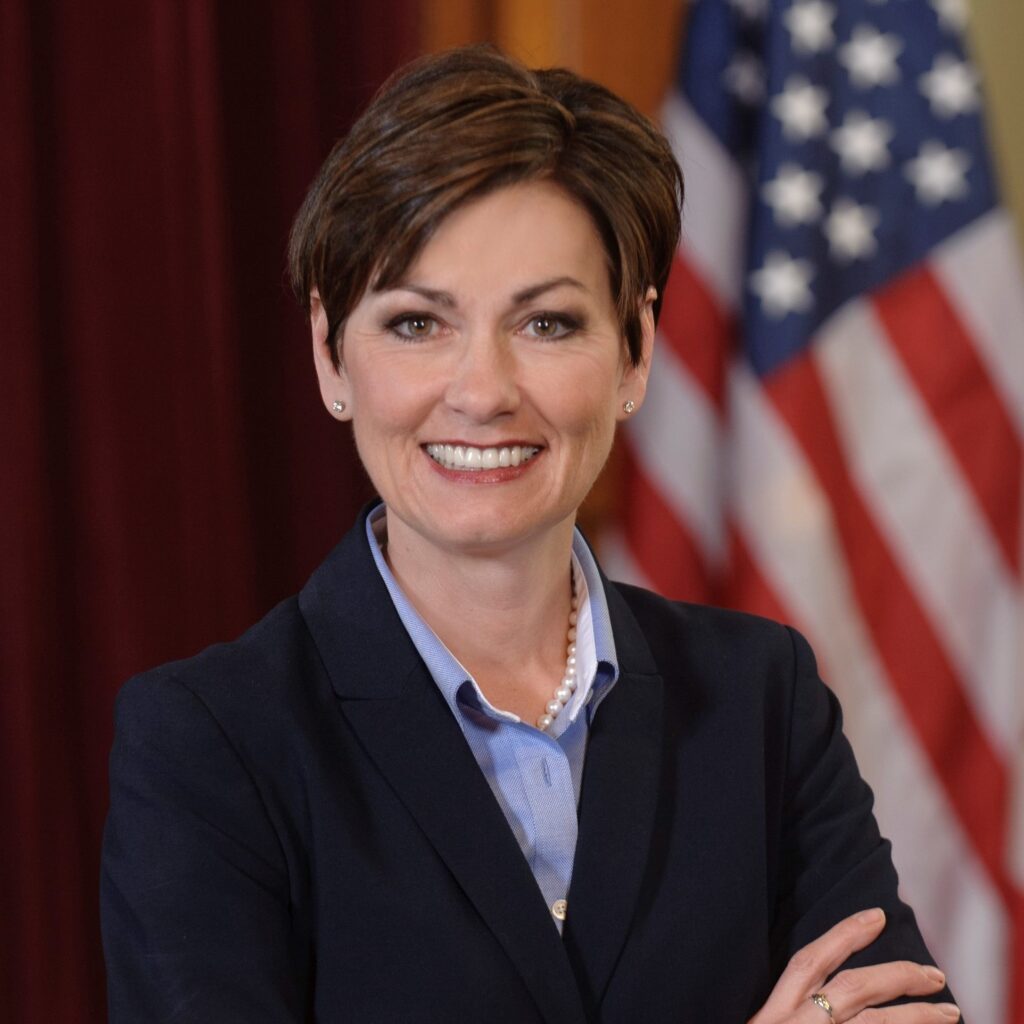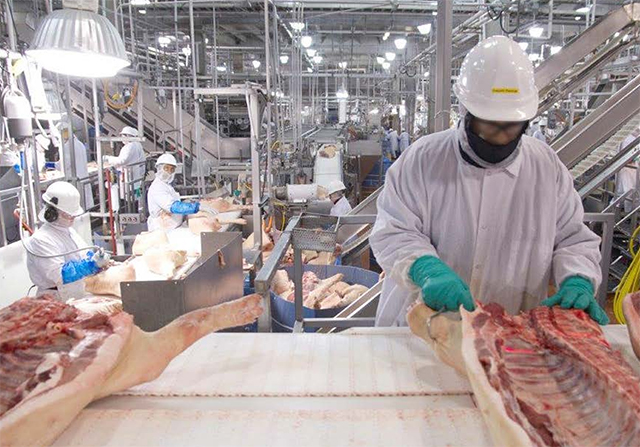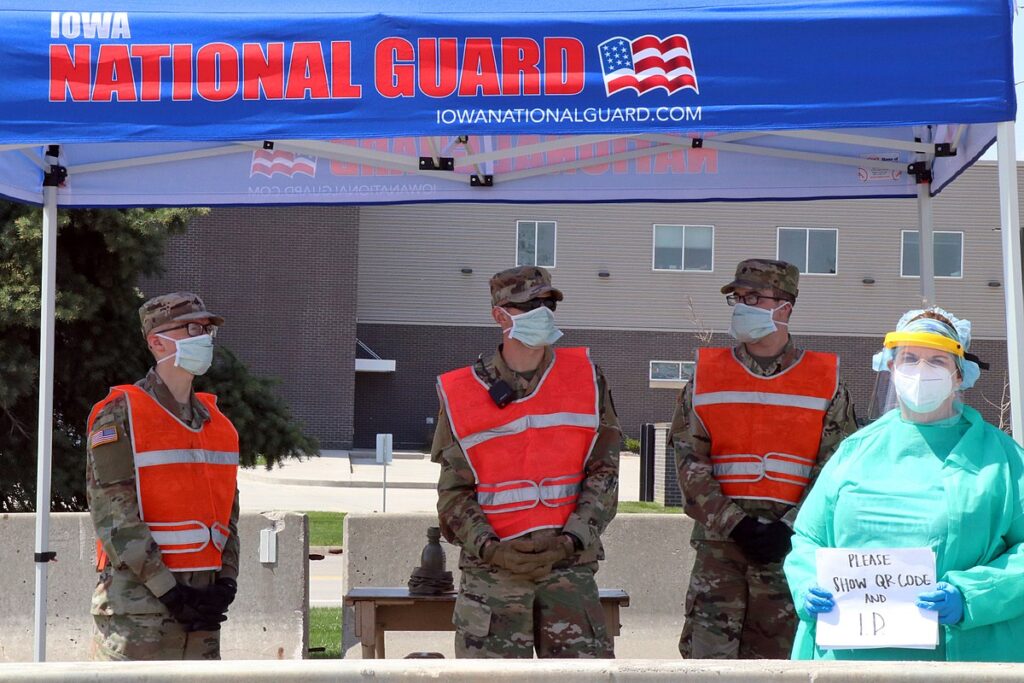April 2020
On April 1, Governor Reynolds changed her statement from a message telling Iowans to stay home when they were sick to “essential errands only” in an attempt to keep COVID-19 case numbers down. Between March 29 and April 1 Iowa’s case numbers jumped 60% and the state broke 1,000 cases on April 7.
A few days later, a model from the University of Washington was released that predicted 420 Iowans would die between April and August 4, and it did not predict a shortage of hospital beds or ICU beds.
This announcement came days before several locations in Iowa experienced outbreaks, specifically in places with high-risk individuals, such as long-term health care facilities.
On April 10, Iowa Department of Public Health made an announcement that Iowans were dreading to hear. Iowa was experiencing a PPE shortage order, requiring health care providers to reuse face masks, use washable gowns, minimize contact with patients, cancel all nonessential appointments, and use telehealth when possible. This came along with the news that the national stockpile of PPE was nearly empty, leaving Iowans wondering what would happen without protection against the virus.
By mid-April, several other events solidified COVID-19’s presence in Iowa. Reynolds announced that Iowa schools would remain closed for the rest of the school year, and northeast Iowa saw added restrictions implemented for the rest of the month. The region reached a level of hospitalizations where Reynolds had said she would consider a stay-at-home order for affected areas. She opted to cancel most social gatherings to dampen the spread.

But nothing reinforced the virus’ spread in April 2020 like the outbreaks in meatpacking plants identified across the state. Throughout the rest of the month the waves of infections caused plant closures in three eastern Iowa cities: Tama, Waterloo and Columbus Junction. The Tyson pork plant in Columbus Junction was the first to close on April 6 following two dozen positive cases and two deaths. Then, the Iowa Premium plant in Tama temporarily shuttered operations after a spike in infections among workers.
Tyson’s pork plant in Waterloo is the company’s largest, so closing it did not come without push back. On April 16, hundreds of employees refused to work claiming conditions inside the plant were unsafe. However, the state was not declaring an official outbreak at the plant. By April 20, two employees from the plant had died and the Black Hawk County Health Department identified an outbreak at the facility, breaking with the state. Local officials favored closing the plant, but Reynolds expressed concern about the effects on the food supply chain. Still, Tyson chose to close the facility two days later after more than 180 workers had reportedly tested positive.

Every change in 2020 felt significant to Iowans, but the end of April marked pivotal decisions determining how Iowa would address COVID-19 going forward. After a month of being closed, Reynolds announced that some businesses could reopen with restrictions in 77 counties starting May 1. The other 22 counties where businesses would stay closed due to higher infection rates notably included those with outbreaks in meatpacking plants. Reynolds said the move came from the need to reboot Iowa’s economy.
Near the end of the month, Iowa reached a single-day high in case numbers with nearly 650 positive cases all reported on April 25. Expanding Iowa’s testing capacity was one way rising numbers were addressed. In late April, Reynolds announced a $26 million public-private initiative called Test Iowa. To many Iowans’ surprise and intrigue, actor and Cedar Rapids local Ashton Kutcher tipped the governor off to the initiative, which was first implemented in Utah. With the program’s added capacity, 5,000 Iowans could be tested each day.
From around 1,000 confirmed cases at the beginning of April to more than 7,100 cases as well as 162 total deaths on April 30, COVID-19 had gradually tightened its grip on the state. The issues Iowans witnessed this month would continue in May as the state began reopening and the mystery of the virus remained.
May 2020
May 2020 in Iowa was defined by the contention around reopening businesses and meatpacking plants following the closures throughout April. Starting immediately on May 1, Iowans in 77 counties could once again eat at a restaurant or go to a gym while following restrictions.
Case numbers also continued climbing. The first of the month marked another single-day high of 740 new positive cases. Less than a week later, the state had garnered nearly 3,000 more confirmed cases.
While the state appeared to be experiencing an increasingly high day to day spike, Reynolds attempted to prevent panic, announcing that there had been a backlog in processing tests, leading to a large increase in positive test results. However, despite Reynolds’ explanation, COVID-19 cases continued to increase, with daily averages of new cases being in the hundreds.
On May 8, the Des Moines Register reported that the Test Iowa system was experiencing issues, noting that several of the tests were potentially damaged. Because of the faulty tests, many people didn’t receive their test results for more than two weeks, contributing to Iowa’s existing issues accurately tracking COVID-19 cases.

This was not the only bad news that Iowans were experiencing about testing. In May, shocking test results came in for employees of meatpacking plants across the state. The Waterloo Tyson plant reopened on May 7 against the backdrop of 35% of its workforce testing positive for the virus or its antibodies. Five of the plant’s employees had also died after contracting COVID-19.
The plants in Columbus Junction and Tama each saw about 40% of its workers test positive, and other plants across Iowa saw similar rates of infection. Reynolds met with former President Trump in early May to discuss the now-official outbreaks at the meatpacking plants. Reynolds offered testing assistance and noted new safety measures implemented by some plants, such as putting up plexiglass dividers between workers.
As Iowans learned more about meatpacking plant outbreaks, more reopenings across Iowa were announced. Starting May 14, hair salons, tattoo parlors, and massage therapists could reopen in any of the state’s 99 counties, lifting the prolonged closure in the 22 counties with higher case numbers. Those 22 counties could also reopen restaurants, retail stores, and gyms with restrictions under Reynolds’ new order.
This same day, Reynolds announced that the State Hygienic Lab validated the Test Iowa COVID-19 tests. They reported that there was a 95% accuracy for a positive test and a 99% accuracy for a negative test.
Amid all the other activity in May, by mid-month Iowa totaled more than 13,000 positive cases and just over 300 deaths.
Nonetheless, reopening continued as scheduled each week. On May 21 recreational businesses like zoos and museums were allowed to reopen. Bars, casinos, and theaters were the last to receive the green light on May 27.
Along with news of reopenings came the announcement from Reynolds that anyone in the state of Iowa who wanted a COVID-19 test would be able to get one starting May 22. This meant that after around two months of strict restrictions limiting COVID-19 tests, more Iowans would now have access to the testing services.
Additionally, the story of Iowa’s meatpacking plant outbreaks did not end when the month came to a close. Another closure occurred at the Storm Lake Tyson plant following positive tests from more than 20% of its workforce. And in 2021, the Iowa Department of Public Health released data estimating one-third of all COVID-19 cases in Iowa through May 31 came from food processing plants, meatpacking plants or farms.
The Iowa Workforce Development also announced that the unemployment rate for April of 2020 was 10.2% compared to the previous year that reported an unemployment rate of 2.7%.
Despite Reynolds’ claim that Iowa was leading the way with its reopening, case numbers continued their rise straight through the last day of May. Iowa totaled nearly 19,500 positive cases by May 31, a 42% jump compared to just two weeks earlier. Deaths due to COVID-19 also rose above 500, a 68% increase from mid-month.
Photo Editor: Anthony Arroyo
